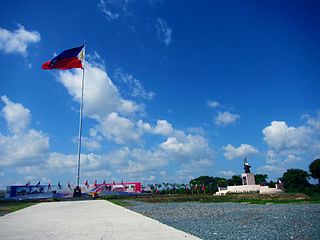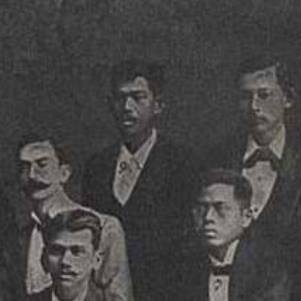
Emilio Aguinaldo y Famy was a Filipino revolutionary, statesman, and military leader who is the youngest president of the Philippines (1899–1901) and became the first president of the Philippines and of an Asian constitutional republic. He led the Philippine forces first against Spain in the Philippine Revolution (1896–1898), then in the Spanish–American War (1898), and finally against the United States during the Philippine–American War (1899–1901).

The Philippine Revolution was a conflict waged by the Filipino revolutionaries against the Spanish colonial authorities in an attempt to win the archipelago's independence.

Gregorio Hilario del Pilar y Sempio was a Filipino general of the Philippine Revolutionary Army during the Philippine–American War.

Pedro Alejandro Paterno y de Vera Ignacio was a Filipino politician infamous for being a turncoat. He was also a poet and a novelist.

Miguel Malvar y Carpio was a Filipino general who served during the Philippine Revolution and, subsequently, during the Philippine–American War. He assumed command of the Philippine revolutionary forces during the latter, following the capture of resistance leader Emilio Aguinaldo by the Americans in 1901. According to some historians, he could have been listed as one of the presidents of the Philippines but, as of 2022, is not recognized as such by the Philippine government.

Mariano M. Álvarez was a Filipino revolutionary and statesman.

San Miguel, officially the Municipality of San Miguel, is a 1st class municipality in the province of Bulacan, Philippines. According to the 2020 census, it has a population of 172,073 people.

The Pact of Biak-na-Bato, signed on December 15, 1897, created a truce between Spanish colonial Governor-General Fernando Primo de Rivera and the revolutionary leader Emilio Aguinaldo to end the Philippine Revolution. Aguinaldo and his fellow revolutionaries were given amnesty and monetary indemnity by the Spanish Government, in return for which the revolutionary government would go into exile in Hong Kong. Aguinaldo had decided to use the money to purchase advance firearms and ammunition later on return to the archipelago.

Mariano Trías y Closas is considered to be the first de facto Philippine Vice President of that revolutionary government established at the Tejeros Convention - an assembly of Philippine revolutionary leaders that elected officials of the revolutionary movement against the colonial government of Spain. When that assembly broke into factions, a truce known as the Pact of Biak-na-Bato was signed by the group and also recognized the elected officials and Trias as the vice president of Emilio Aguinaldo, who is also considered to be the first President of the Philippines. With the promulgation of the Malolos Constitution by the Malolos Convention, the First Philippine Republic was born. Under the Aguinaldo administration, Trias served in the cabinet initially as Secretary of Finance and, later, as Secretary of War.

The Republic of Biak-na-Bato was the second revolutionary republican government led by Emilio Aguinaldo during the Philippine Revolution that referred to itself as the Republic of the Philippines and was seated in what is now Biak-na-Bato National Park. The current designation was adopted by historians to avoid confusion with the name of the current Philippine government, which also refers to itself as the Republic of the Philippines, and with other past Philippine governments using the same designation.

The Battle of Binakayan–Dalahican was a simultaneous battle during the Philippine Revolution that was fought on November 9–11, 1896 that led to a decisive Filipino victory. The twin battle took place at the shores of Binakayan, in the town of Cavite Viejo ; Dalahican and Dagatan in Noveleta; and, to minimal extent, in Imus and Bacoor towns in Cavite, Philippines that lasted for two days before the Spanish army retreated demoralized and in disarray. The result of the battle was the first significant Filipino victory in the country's history.
This is a list of notable events that happened in the Philippines in the year 1897.

The Battle of Alapan was fought on May 28, 1898, and was the first military victory of the Filipino Revolutionaries led by Emilio Aguinaldo after his return to the Philippines from Hong Kong. After the American naval victory in the Battle of Manila Bay, Aguinaldo returned from exile in Hong Kong, reconstituted the Philippine Revolutionary Army, and fought against the Spanish troops in a garrison in Alapan, Imus, Cavite. The battle lasted for five hours, from 10:00 A.M. to 3:00 P.M.
The Battle of Aliaga was fought on September 4–5, 1897, between the Philippine revolutionaries of Nueva Ecija and the Spanish forces of Governor General Primo de Rivera.
The Battle of San Mateo and Montalban was a battle fought between the remaining Katipuneros under the command of Andres Bonifacio and Emilio Jacinto and the Spanish government after a failed attempt to capture the El Deposito water works at San Juan del Monte.

General Mamerto Alejandrino Natividad was a haciendero and a Filipino military leader who led numerous successful battles during the Philippine Revolution against the Spaniards. He is credited with establishing army headquarters at Biak Na Bato, which today is a national park because of its historical significance. Together with Jose Clemente Zulueta, he wrote the proclamation entitled “To The Brave Sons of the Philippines”, which called for the expulsion of the friars from the Philippines. He was a signatory to the Biak Na Bato convention, but a steadfast dissenter to the Treaty of Biak Na Bato, which asked for peace and reforms. He preferred independence.
This is the timeline of the El Filibusterismo . It contains details before and after public of El Filibusterismo.

Salvador Estrella was a Filipino general who fought in the Philippine Revolution and the Philippine–American War. For his courage in battle, he earned the moniker "red blooded."

Tirad Pass: The Last Stand of Gen. Gregorio del Pilar is a 1996 Philippine biographical epic film directed by Carlo J. Caparas and starring Romnick Sarmenta as the titular Gregorio del Pilar, one of the youngest Filipino generals during the Philippine–American War, who died in the Battle of Tirad Pass.
The Battle of Mount Puray, sometimes known as Battle of Mount Purog, was fought on June 14, 1897, between the Philippine revolutionaries led by Revolutionary President Emilio Aguinaldo and General Licerio Geronimo and Spanish forces sent under orders by Governor-General Fernando Primo de Rivera. Filipino forces won a victory in this battle in which a Spanish army pursuing them was crushed and routed. The Filipinos' victory in the battle ended the long evacuation from Cavite to Morong, and made possible the setting up of their new revolutionary headquarters in the battlefield's vicinity and then later to Biac-na-Bato in Bulacan.















